Previously, we discussed how in the current era of smartphone performance transparency, with minimal hardware differences among products in the same price range, color accuracy optimization at the software level has become a more important reference for smartphone color presentation. Currently, the color calibration solutions (software) for smartphones are mainly built on the two major platforms of Qualcomm and MediaTek (MTK). How do these two platforms perform in terms of color accuracy? Let’s delve deeper into this topic.
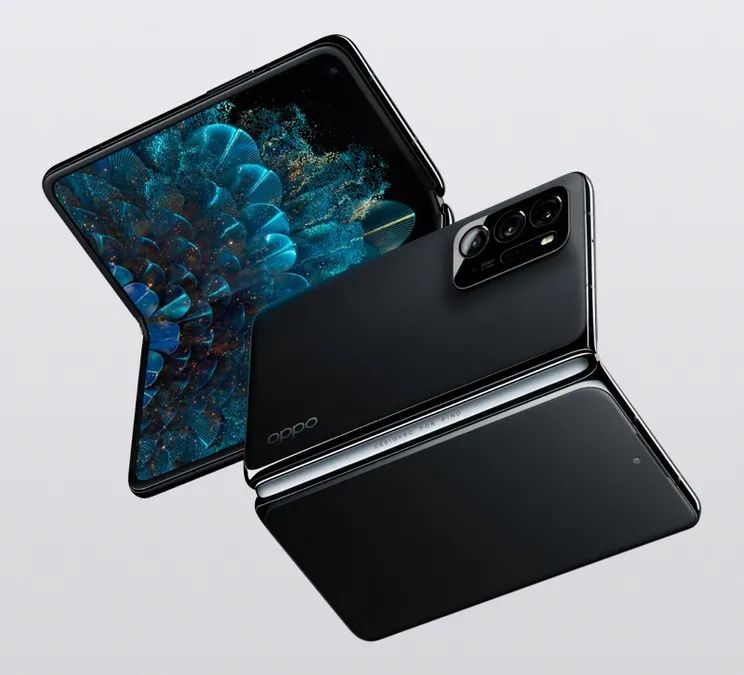
Source: OPPO Official Website
On the Qualcomm platform, Pixelworks provides a more advanced and efficient color calibration solution
In the past, most smartphones, especially flagship models, were equipped with Qualcomm platforms. The color correction solutions on the Qualcomm platform are divided into two categories: one is the proprietary solution, and the other uses the Pro Software visual display solution developed by Pixelworks for the Qualcomm platform. Recently released models such as OPPO Find N, FIND X3 series, OnePlus 10 Pro, and iQOO 9 series all utilize the Pixelworks color calibration solution.
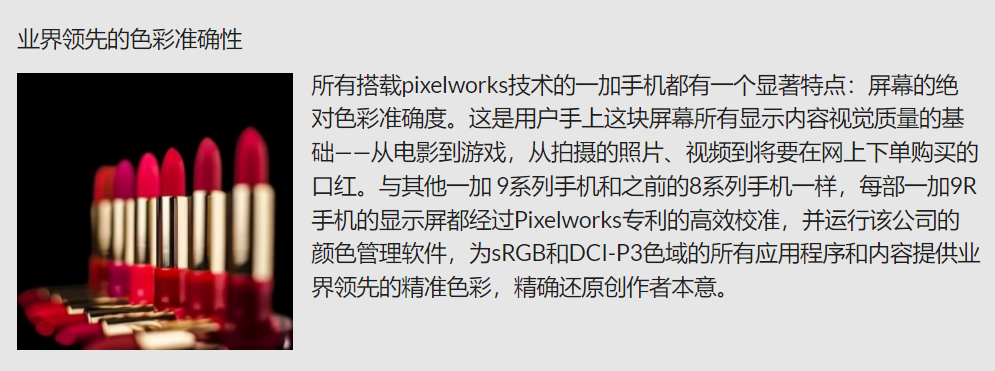
Source: Pixelworks Official Website
It is reported that the biggest difference between the two lies in the production line calibration stage. The Qualcomm proprietary solution selects 40 color points and completes calibration within one minute, while the Pixelworks solution only requires selecting 21 color points and can complete calibration in 15 seconds. According to third-party reports/promotions, the Pixelworks solution seems to handle color details more delicately and efficiently, and can save more time for smartphone manufacturers during production line calibration, thus gaining favor from many domestic smartphone manufacturers.
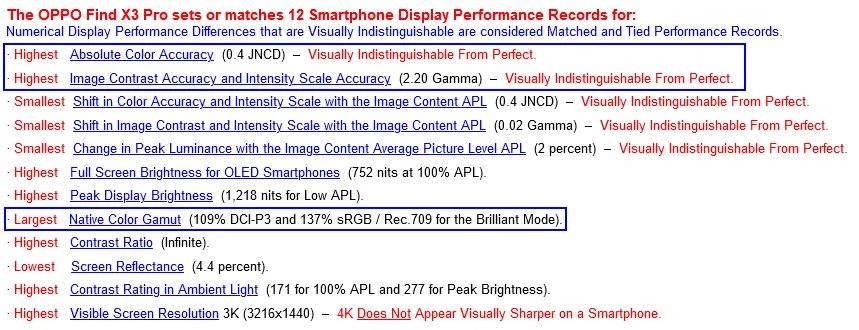
Source: DisplayMate Official Website
So, is this really the case? Next, let’s get to the bottom of this. We extracted the screen testing results of the OPPO Find X3 Pro released last year from the authoritative screen testing organization DisplayMate. We can see that this phone supports 109% DCI-P3 and 137% sRGB/Rec.709 ultra-wide color gamut (official data shows 100% DCI-P3), while its absolute color accuracy reaches 0.4 JNCD. We have previously shared that the smaller the JNCD value, the better; any value below 1 indicates a professional-grade screen.
At the same time, the human eye can receive different light in different environments, leading to temporary adaptation issues when transitioning from outdoor to indoor. The human eye experiences similar situations when viewing smartphone screens. Fortunately, this change is also traceable and controllable; simply controlling the Gamma value at 2.2 can achieve a more realistic and natural viewing experience (displays with a gamma value of 2.2 are used as the standard by graphics and video professionals). The Pixelworks color correction solution uses adaptive brightness calibration technology to ensure that the Gamma value of the OPPO Find X3 Pro is stably maintained at 2.2. This value allows users to enjoy a natural and realistic screen display effect in various visual scenarios, whether chatting on social media, browsing the web, watching movies, or gaming, providing a consistently comfortable and pleasant sensory experience.

Source: DisplayMate Official Website

Next, let’s compare with the industry benchmark iPhone 13 Pro Max, which supports 100% DCI-P3 wide color gamut, achieving a JNCD value of 0.5 between sRGB and DCI-P3 color gamuts, with a Gamma value of 2.21. The above results indicate that the OPPO Find X3 Pro and iPhone 13 Pro Max are comparable in color accuracy, with the Find X3 Pro even slightly outperforming in JNCD. It is worth noting that the iPhone 13 Pro Max was released six months after the OPPO Find X3 Pro, and although DisplayMate’s testing processes and methods may have slight adjustments, the two phones operate on different operating systems, and the iPhone’s screen color calibration is recognized as expert-level in the industry. Therefore, this balanced result shows that the Pixelworks color correction solution is increasingly persuasive in Android smartphones.
Pixelworks Color Correction Solution Achieves Initial Success on MTK Platform
Recently, MediaTek (MTK) officially launched the new generation flagship product Dimensity 9000 for its 5G mobile platform. This chip is built on TSMC’s advanced 4nm process technology and adopts an advanced 1+3+4 tri-cluster flagship architecture, with a maximum CPU frequency of 3.05GHz, achieving breakthroughs in both performance and power consumption. This SoC chip stands on the same starting line as Qualcomm’s Snapdragon 8 Gen 1, even surpassing it in core frequency.
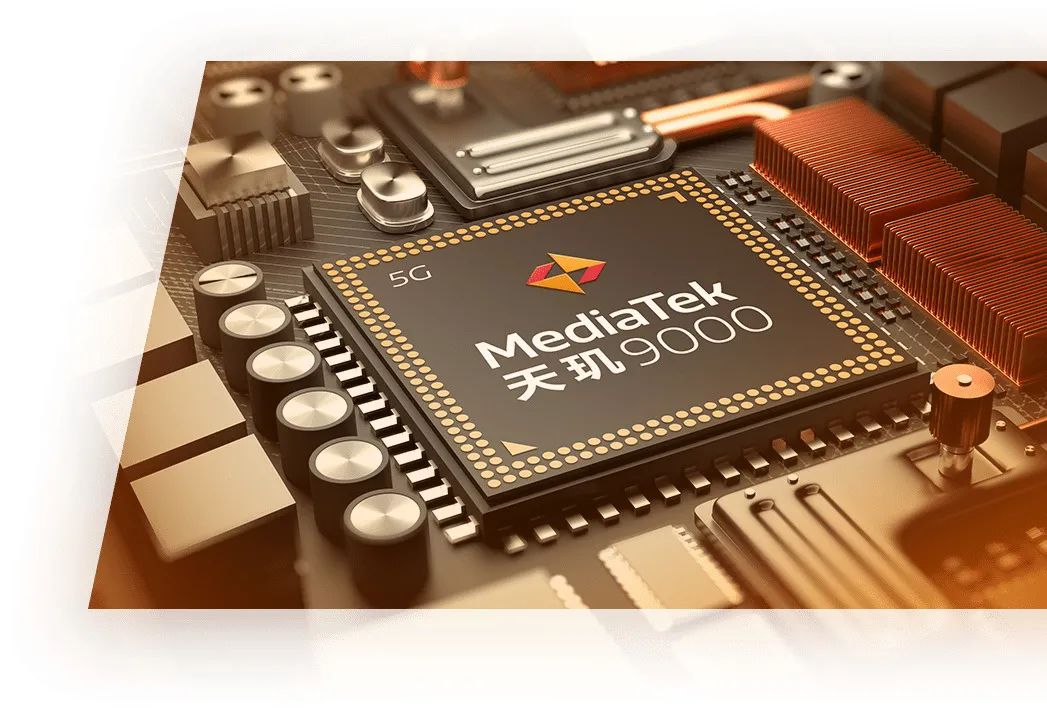
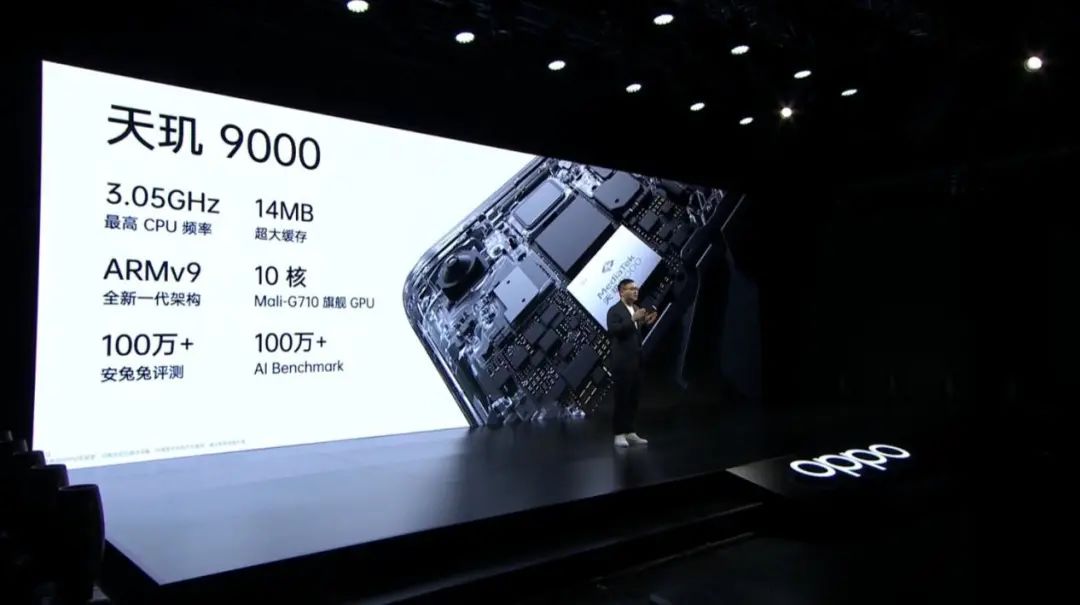
Source: OPPO Find X5 Series Launch Event
Although the launch of Dimensity 9000 has garnered widespread attention from both inside and outside the industry, many smartphone manufacturers accustomed to using Qualcomm platforms in mid-to-high-end flagship models remain cautious about whether they can maintain the same excellent flagship performance experience after switching to the Dimensity 9000 mobile platform. Fortunately, the OPPO Find X5 Pro Dimensity version, which first equipped this SoC chip, has delivered an excellent performance, with all test data objectively and adequately proving the formidable performance of Dimensity 9000.
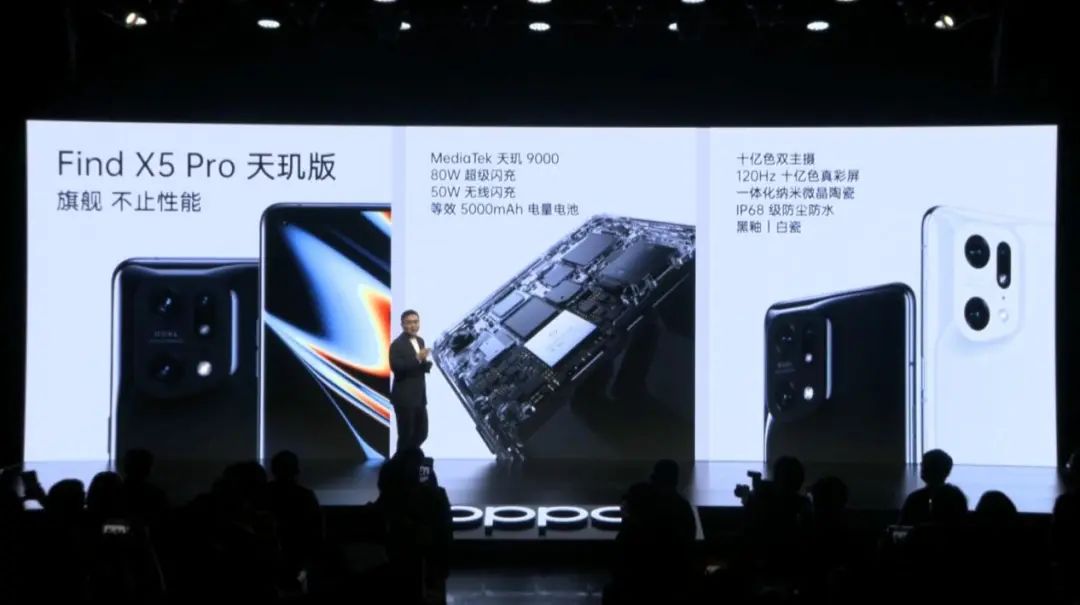

Source: OPPO Find X5 Series Launch Event
It should be noted that the MediaTek Dimensity 9000, as a new flagship mobile platform, currently lacks its own developed color calibration technology, and therefore uses the color correction solution developed by its partner Pixelworks. It can be seen that the OPPO Find X5 Pro Dimensity version achieves excellent standards in various display metrics, supporting a maximum peak brightness of 1300 nits, true color display with 1.07 billion colors, 100% P3 color gamut coverage, and also achieving a JNCD value of about 0.4. This ensures that the display colors of the OPPO Find X5 Pro Dimensity version remain natural, brilliant, and detailed, with no difference in display effects compared to the other two Snapdragon-equipped models.
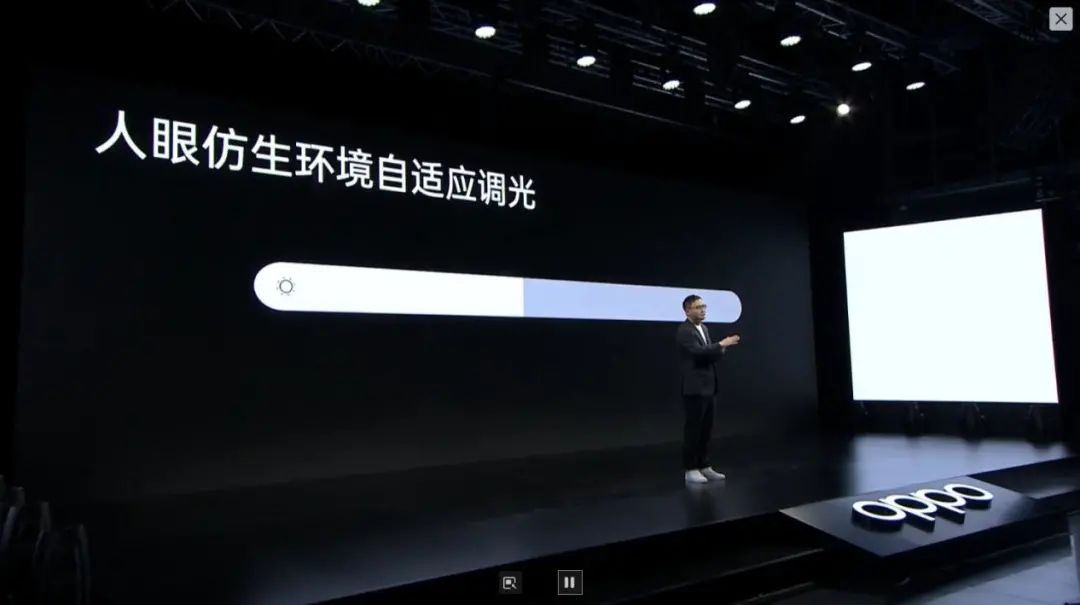
This OPPO Find X5 series launch event focused on introducing the “human eye bionic environment adaptive dimming”, which adjusts the previously mentioned Gamma value. While maintaining an excellent score of 2.2, it adds 12 dimming speeds, increasing the adjustable brightness levels by 100% in low-light environments. These features further enhance the smoothness and comfort of screen light changes, effectively alleviating the impact of screen flickering on the eyes, thus providing a more comfortable screen usage experience.
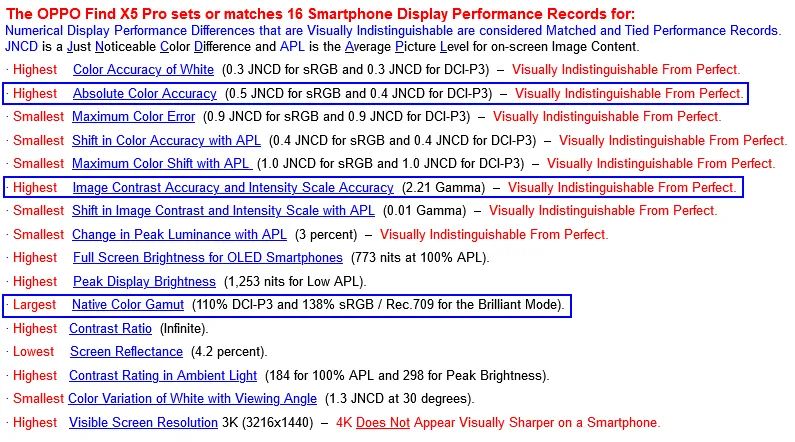
Source: DisplayMate Official Website
DisplayMate also tested the OPPO Find X5 Pro, although it did not specify whether it was the Dimensity version or the Qualcomm version, but the color parameters of both products are completely consistent and were inspected by relevant departments before market sales. According to third-party results, the new generation model supports 110% DCI-P3 and 138% sRGB/Rec.709 color gamut, with the Dimensity version achieving a JNCD of 0.4 and a Gamma value controlled at 2.21. It is worth noting that DisplayMate provided an important summary of 16 key parameters this time, which is an increase of 4 parameters compared to a year ago, indicating a more complex testing process and stricter evaluation standards.

From Pixelworks’ official news, it can be seen that the two officially announced their cooperation at the end of last year, meaning that in a very short time, their technologies were successfully integrated into the OPPO Find X5 Pro Dimensity version flagship phone, and the testing data objectively proves that the Dimensity version of Find X5 Pro is on par with the Qualcomm version in color accuracy performance, and even surpasses it in color gamut. It is worth mentioning that although the Dimensity 9000 and Snapdragon 8 Gen 1 are both built on the ARM V9 architecture, due to differences in design routes and process technologies, achieving the same maturity and compatibility level as the Qualcomm platform in a short time is highly challenging, requiring both technical teams to work together to meet the ideal standards. From another perspective, the fact that Pixelworks has received unanimous favor and recognition from both Qualcomm and MediaTek can also indirectly suggest that Pixelworks leads the industry in screen color calibration.
After the launch event, consumer interest in the OPPO Find X5 Pro Dimensity version has remained high. The successful debut of the Dimensity 9000 has provided consumers with more choices when purchasing smartphones, especially flagship models.
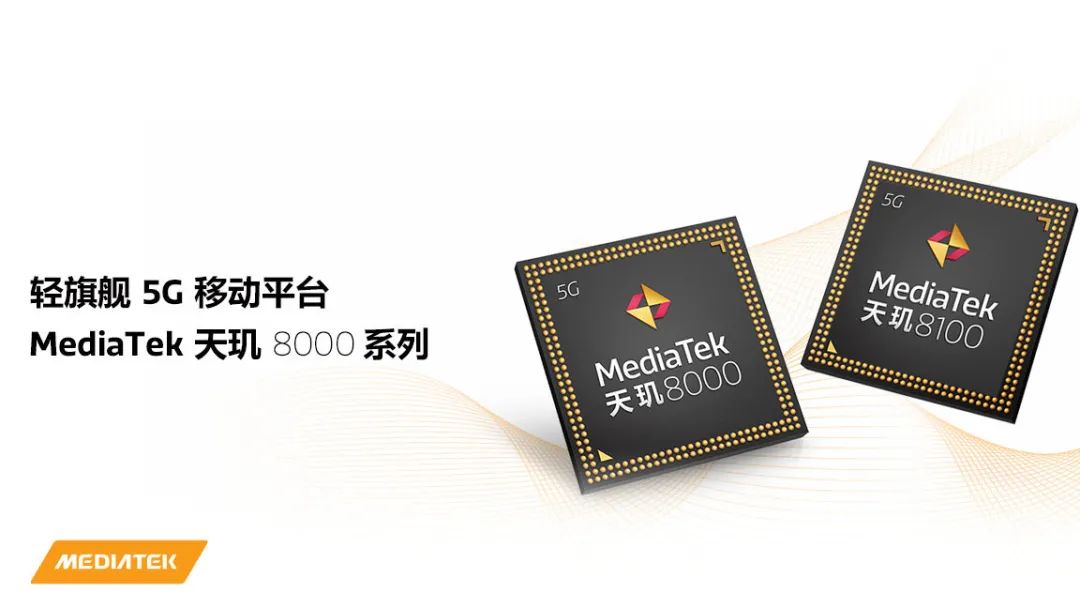
Source: MediaTek Official Weibo
On March 1, MediaTek released the latest light flagship mobile platforms Dimensity 8000 and 8100, both adopting an octa-core CPU architecture and built on TSMC’s 5nm process technology, with clock speeds reaching 2.85GHz and 2.75GHz respectively. In GeekBench 5 multi-core testing, performance and efficiency compared to competing models have been improved by 12% and 44% respectively, delivering strong performance while effectively reducing power consumption. Previously, a digital blogger also shared impressive results of 820,000 AnTuTu scores for the Dimensity 8000.
According to relevant sources, Pixelworks will continue to provide strong support for Dimensity 8000 and 8100, and improvements in color and other aspects will surely allow users to enjoy a more authentic visual experience when watching movies and also immerse themselves better in the “virtual world” while gaming, thus providing a higher quality user experience.
When selecting a suitable flagship model, in addition to considering common dimensions such as mobile platform, hardware configuration, and battery life, users might also consider the performance of the phone in display capabilities, as smartphones now cover most visual application scenarios. Of course, as Pixelworks deepens its cooperation with mobile platforms and other technical partners, choosing a smartphone screen experience with high picture quality, high color fidelity, high frame rates, and low power consumption may become simpler.
Previous Review:In addition to external hardware performance, the power of smartphones also relies on excellent color presentation.